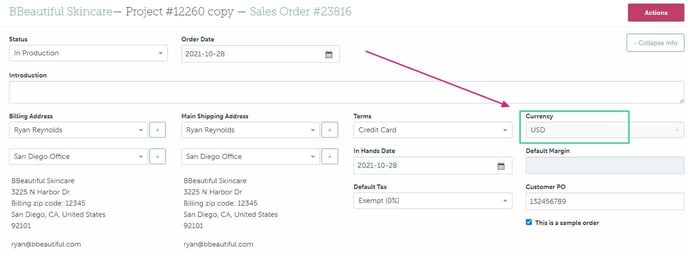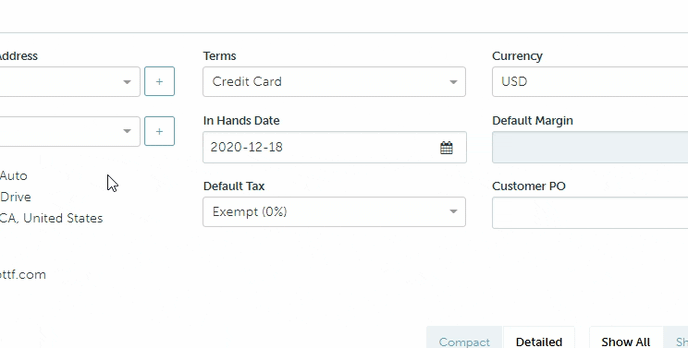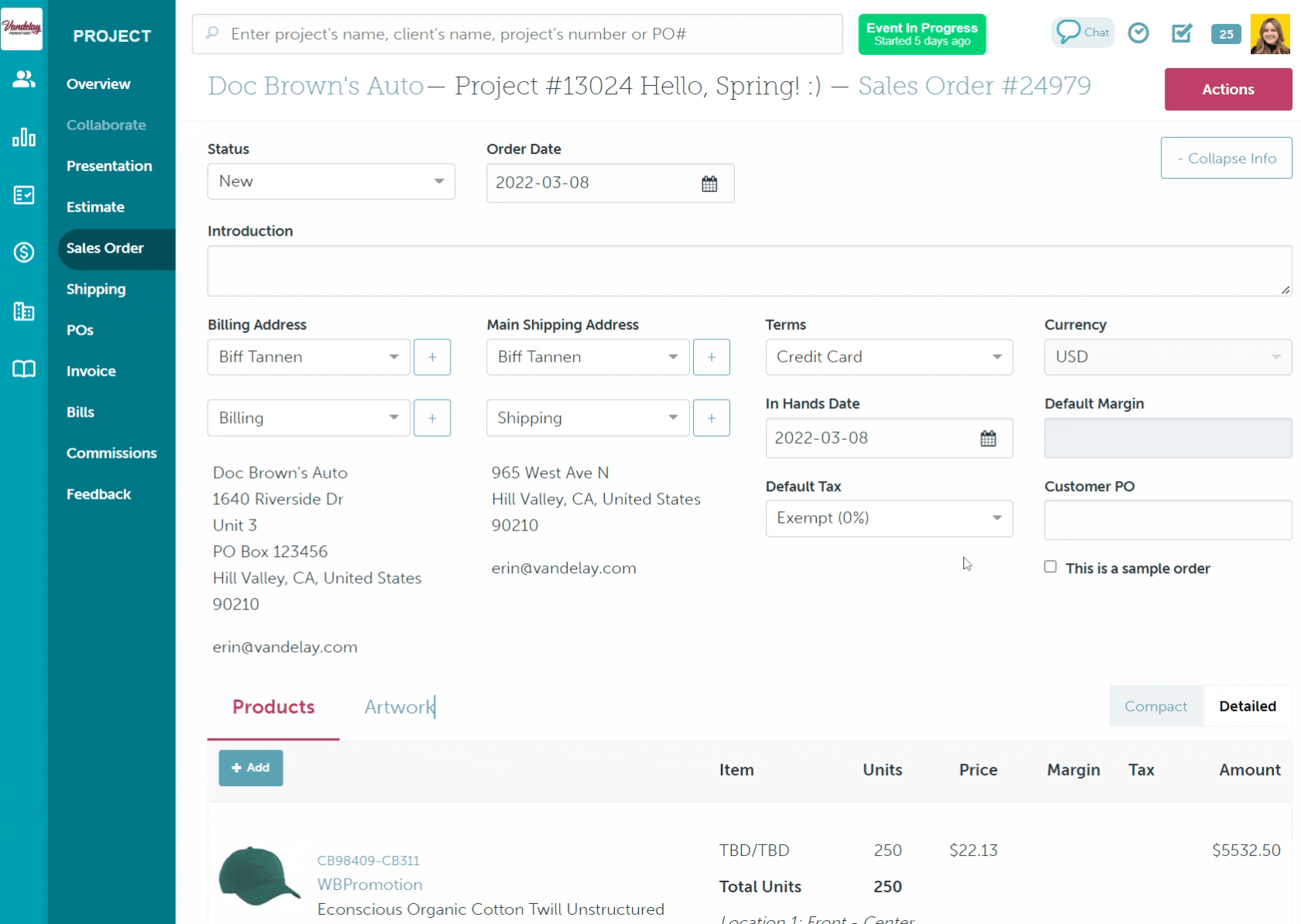Sales Order Settings
Learn more about the different settings and features on your sales orders.
On this page:
Status
Sales order statuses track the progress of an order. Almost all of the statuses are automatically applied, but you can also change them manually.
To change a sales order's status, click the "Status" drop-down and select a status from the list.
.jpeg?width=688&height=248&name=Doc-Brown-s-Auto-Project-10566-New-Project-%20(1).jpeg)
Order Date
The order date is internal-facing and does not show to your client. It defaults to the sales order's creation date and is useful for future reporting.
To change the order date, click into the "Order Date" field and select the date you need from the calendar.
Introduction
The introduction appears at the very top of the sales order. It's used to provide the client with additional details or instructions for their sales order form. You can add plain text or dress it up with HTML coding, including iframes.
Client contacts and addresses
The client's billing and shipping contacts and addresses appear at the top of the sales order form.
To change/select the billing or shipping contact, either:
- Click the relevant contact drop-down and choose a contact from the list (as listed on the client page)
- Click the + icon to add a new client contact
.png?width=688&height=283&name=Doc-Brown-s-Auto-Project-10566-New-Project-%20(2).png)
To change/select the billing or shipping address, either:
- Click the relevant address drop-down and choose an address from the list (as listed on the client page)
- Click the + icon to add a new client address
-1.png?width=688&height=283&name=Doc-Brown-s-Auto-Project-10566-New-Project-%20(2)-1.png)
Terms (payment)
The "Terms" field automatically populates with your client's default payment terms, as set on the client page. To change the payment terms on a sales order, click the "Terms" drop-down and select a term from the list.
-2.png?width=688&height=283&name=Doc-Brown-s-Auto-Project-10566-New-Project-%20(2)-2.png)
You can customize your list of payment terms through the Admin tab > Settings.
Currency
This field determines the currency your client will see on their order and defaults to the currency set on the project overview. The best practice is to create separate commonsku clients for each currency your client operates in; that keeps reporting clean inside commonsku and makes it easier to export to your accounting platform.

Feel free to contact support@commonsku.com if you have questions about multi-currency.
In Hands Date
The in-hands date is pulled from the project overview's Project Info or the presentation/estimate's in-hands date. The in-hands date represents when the product needs to be "in the client's hands."
To update the in-hands date, either:
- Click the In Hands Date field on the project overview and select the date you need
.jpeg?width=688&height=273&name=Doc-Brown-s-Auto-Project-10566-New-Project-%20(3).jpeg)
- Click the In Hands Date field on any on the sales order and select the date you need
.png?width=688&height=293&name=Doc-Brown-s-Auto-Project-10566-New-Project-%20(4).png)
Updating the in-hands date on the project overview only updates the in-hands date on the most recently created form.
Default Tax
The default tax uses the tax set on the client's page.
To change the sales order's default tax, click the "Default" Tax drop-down and select a tax code.
-1.png?width=688&height=293&name=Doc-Brown-s-Auto-Project-10566-New-Project-%20(4)-1.png)
If you're using Zip2Tax and need to override the tax listed:
- Click the "Default Tax" drop-down
- Type the client's zip code into the field and select the tax you need or choose "Exempt"

Zip2Tax automatically applies a tax rate based on the sales order's shipping address, as long as the state is listed in your Tax Nexus.
If you're using Avalara and need to override the tax listed:
- Click the "Default Tax" drop-down and choose Avalara
- Select a Default Avalara Category (if needed)
- Select the order's billing and shipping address (a valid shipping address is required to calculate tax)
- After ALL products and services are added and edited as needed, click the Calculate Tax button to calculate a combined tax rate based on the current order details (see best practices)

Customer PO
You can type your customer's purchase order number into this field; it will appear at the top of the sales order.
[Back to top]Sample orders
Check the box next to "This is a sample order," to add the sample order to your Sample Report.
.png?width=688&height=420&name=Doc-Brown-s-Auto-Project-10566-New-Project-%20(5).png)
Products and artwork
Toggle between the Products and Artwork tabs to view the sales order's items and their artwork details.
[Back to top]Compact vs. Detailed
You can view the internal version of the sales order in either Compact or Detailed view. The internal view does not affect the client-facing sales order.
Click Compact to view a product's:
- SKU
- Supplier name
- Product name
- Total units
- Margin % per line item
- Client price per line item
The Detailed view is the default setting; it shows a product's:
- SKU
- Supplier name
- Product name
- Product description
- Total units
- Product variants (sizes and colors)
- Margin % per line item
- Client price per line item

+Add products
Click the + Add product button to add products to your sales order.

+ Title
Click the + Title button to add Titles or categories to group your products.

+ Services
Click the + Services button to add Services including Custom Service, Freight, Fulfillment, Shipping, Service Po and Other Service

If a custom service has been established in the default settings, it will be displayed as a named service.
Edit, copy, delete
If you hover over a product, you can select to:
- Edit - opens the editing screen for you to change the information displayed to your client.
- Copy - creates a duplicate product.
- Delete - removes the product from the sales order.
.png?width=688&height=282&name=Doc-Brown-s-Auto-Project-10566-New-Project-%20(10).png)
Require a deposit
You can create a deposit invoice to collect (partial) payment from your client before creating a final invoice.
.jpeg?width=688&height=212&name=Doc-Brown-s-Auto-Project-10566-New-Project-%20(11).jpeg)
Right-click shortcuts
If you hover over a product, you can right-click and select:
- Copy - creates a duplicate product.
- Product - opens your product databases to add a new item under the product you right-clicked on.
- Title - adds a title directly above the product; titles are a simple way to create product categories.
- Freight, Fulfillment, Shipping, Other Service - allows you to quickly add additional services.
FAQ
- How can I hide the costs like in a presentation?
- How do I unlock a locked sales order?
- Why can't I unlock my sales order?
How can I hide the costs like in a presentation?
Unlike a presentation, it is impossible to "hide" pricing all together on a sales order. The only option is to change each product's retail price to $0.
How do I unlock a locked sales order?
Sales orders automatically lock once they're invoiced; commonsku assumes the details on the sales order are final. However, you can unlock the sales order if you need to make changes or delete the form.
To unlock the sales order, click on the greyed-out Unlocked button on the far right just above your products/line items.
.jpeg?width=688&height=277&name=Doc-Brown-s-Auto-Project-10566-New-Project-%20(13).jpeg)
Why can't I unlock my sales order?
You need permission to "Unlock Orders" to unlock sales orders and invoices. You can either ask your admin to unlock the form or ask them to assign you the permission.